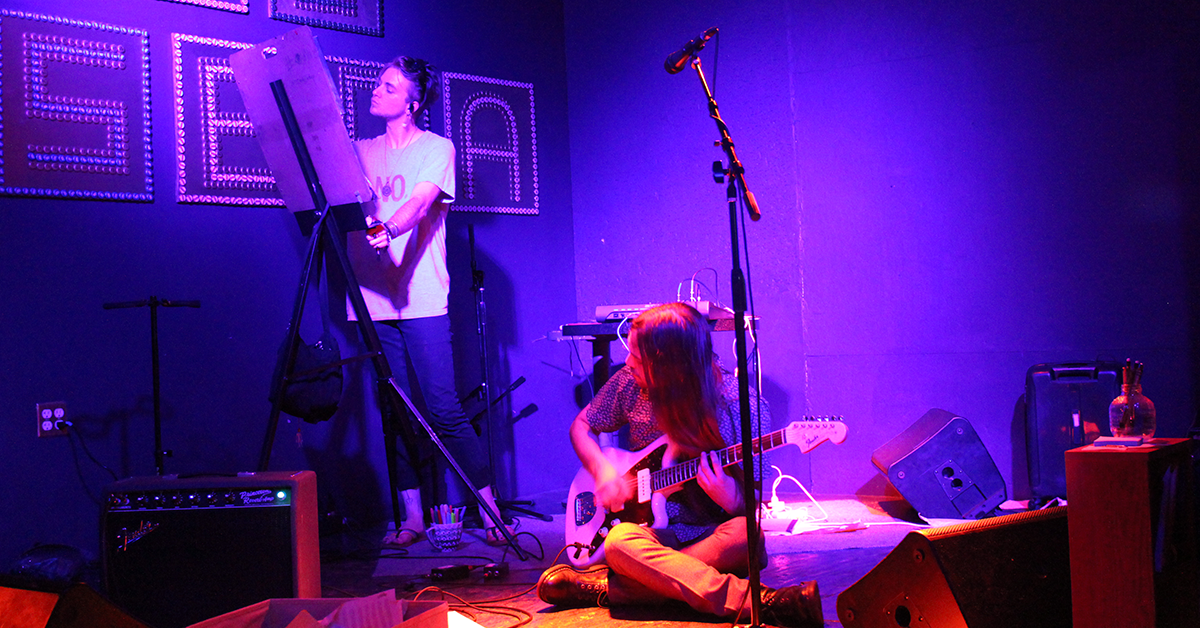La Fin Du Monde: Long Beach’s Newest Experimental Music Night
10 minute readYou might have stumbled into Que Sera on Earth Day expecting to see a few bands or a chill DJ set—thinking maybe you’d consider the climatological crisis while nursing a beer.
Instead you would have walked in on someone in a dinosaur mask fidgeting with a microphone while a saxophonist in all black lumbered through a simple but ominous melody and a cross-legged guitarist chugged through some distorted chords.
The dinosaur mask comes off and underneath, a gas mask. Then the gas mask comes off and underneath, a black spandex hood. The anonymous front person (if this performance does in fact have a front) walks off stage five minutes before it’s finished. She takes off her final mask and launches into conversation, returning to her role as an audience member…
This was the fourth installment of La Fin Du Monde, an ongoing concert series hosted at Que Sera (a bar and music venue near the corner of Seventh Street and Cherry Avenue). The mysterious masked performer and the would-be jazz man are also the series creators: Emily Wasilewski and Griffin Rogers. Both are in bands; Wasilweski fronts the band Courtaud and Bobtail and Rogers is a guitarist/vocalist for Nifegun. This night though they performed as the one-off project Emifin Rogerski, a portmanteau of their names. They were joined by Chris Swiderski on guitar.
The night is a showcase for experimental music, a departure from the usual three or four rock band bill.
“I kind of just want it to be like something really weird,” said Wasilewski. She envisioned something “raw” and “uncomfortable,” where an unbeknownst bar-goer might be confronted by “this really obscure thing going on.”
It seems likely that this objective was met.
Brent Vallefuoco was maybe the night’s most literary performance, with spoken word and excerpts read from David Foster Wallace’s “Brief Interviews with Hideous Men” on top of layered sound and live, on-stage painting by artist Van Donahue. Sharing the stage, violinist Emerson Sinclair read a monologue and plucked dissonant notes. Notebooks were passed out during the performance, an invitation for the audience to join the action with doodling or jotting down of disparate thoughts.
A long-haired gentleman in a leather jacket passed out copies of Luke Turner’s “Metamodernist Manifesto.” Large proclamations fill the page: “We recognize oscillation to be the natural order of the world” and “The present is a symptom of the twin birth of immediacy and obsolescence.”
Along with music and sound art, the series also featured visual artists, such as yourintimatenoise aka Jess Giles, a Long Beach film photographer whose work is characterized by light leaks, color, and moments of contemplations between her subjects and themselves.
The series name, La Fin Du Monde (French for “the end of the world”) is a bit ironic on the night of an annual event meant to support environmental protections. Rogers explained that it was a reference to a Québécois beer with a high alcohol content and a cool label.
“When [Griffin] translated it to me,” said Wasilewski, “I was like, ‘Oh, perfect.’”
For her, improvised performance is an especially important element.
“It’s just nice to have something that’s not rehearsed… If [an artist is] interested in doing something they can, and they don’t have to worry about practicing their band twice a week or something,” said Wasilewski.
“It’s like kind of nerve wracking that what you’re doing can fall apart at any moment,” adds Rogers, “It’s also relaxing too because, it doesn’t matter. At the end of the day you’re on stage and you’re performing so that’s cool. That’s what you want to do.”
Although La Fin Du Monde is a series is fairly new the night’s bill also included an international act.
Roberta Busechian, a sound artist and researcher based in Milan, started collecting sounds years ago while studying visual arts at Università Iuav di Venezia. Her performances often include visual installation and ambient sounds comprised of field recordings.
The visual components work as “architecture” that encapsulate the audience in “shapes and light.” Sound is used as a “communication tool,” Busechian explained, which she was attracted to as a means of “involv[ing] the public scene within the act of recording.” She says she experiments with “how to express visions and how to connect with the audience in a very intimate way.”
When finding field recordings, Busechian normally records sounds with “many harmonics” but is not looking for a particular sound. She explains that she looks for “ambiental noises, crowds, unexpected situations in the urban environments.”
“Recording is a way to think, to stop and be aware of the reality,” said Busechian, “that is also connected with my inside emotional situation.”
The show’s two other acts grew out of Cal State Long Beach’s Music Composition program.
Pile of Wires, an electroacoustic laptop ensemble, enveloped the audience in screeching metallic tones were punctuated with eruptions of bass. Member Sean Jones was even a little worried about the PA holding up under the sporadic explosions of sound.
The group’s muted physicality (transfixed laptop gazing while working midi controllers; knowing glances between members as the pieces progressed), contrasted with their music, which felt like being in the bowels of a spaceship careening towards some destination you’re not quite sure it will make.
Pile of Wires has two other members, David García Saldaña and Cameron Johnston. Hours before the show, Jones talked about the abstract concepts underpinning the project and how his own musical background began quite separately from academia.
Jones started making music in earnest when he was about 10. His older brother, at the advanced age of 13, was part of a noise band and turned him on to it. Along with a two-tape Boombox, which allowed for crude overdubbing, Jones started making layered music pieces.
“I had a violin, which was really key. You get some really gnarly sounds out of that.
I had this Kramer [Voyager] that my brother gave me—a guitar shaped like a star, sparkly. And a tiny little amp that was not ever not distorted, cause it was so small … And screaming,” Jones recounts.
Tomisin Oluwole
Coquette
Acrylic on canvas
18 x 24 inches
Click here to check out our interview with Tomisin Oluwole, a a literary and visual artist based in Long Beach.

Instead of gunking up our site with ads, we use this space to display and promote the work of local artists.
These early experiments eventually led Jones to join noisy indie bands in his twenties while living in Salt Lake City. He described the Salt Lake City scene as being “rough” and “rowdy” with “a lot of heavy drinkers, a lot of drugs.” Many members of the community were ex-Mormons rebelling against their straight-laced backgrounds. Others, like Jones, were coming at it with their own forms of alienation.
After going on some tours and cutting a few records, Jones became complacent with band life and turned to college to postpone his “existential dread.”
“I needed something,” Jones said.
While the new knowledge he’s acquired in the program has been musically liberating, Jones also feels a bit out of touch with many of his newfound peers.
“I’m used to [a] music scene being an expression of rebellion,” something Jones does not see a lot of in the New Music world.
New Music refers to contemporary classical music that pushes the boundaries of the genre by incorporating non-traditional instrumentation, techniques, and concepts.
“I don’t think there’s a whole lot of oppressed people that take part in the New Music world. There are some. And I don’t mean to say that I’m super oppressed, I know that I’m not. But whatever sentiment of rebellion [I was experiencing], I did want to express [it], certainly, with my peers,” said Jones. “It’s hard acclimating to a music culture that doesn’t have some kind of social significance.”
Pile of Wires is still developing as a project and in fact, their Que Sera performance marked their first outside the context of the university. One concept that Jones says has informed Pile of Wires (and probably relates to its tangled handle) is an interest in “the points of distinction between objects perceived as distinct and separate.”
Pretty heady, but what does it mean?
“All I’m trying to get at is that we perceive the thingness of this and the thingness of that as two distinct phenomena,” explains Jones. “But if you zoom in, on whatever, wherever that distinction is, between this thing and that thing, that distinction doesn’t exist. It’s porous. There’s no dividing line [between] me and you, right. So I think that’s just a really fruitful consideration as an artist: focusing on where the division between two things fails.”
A musical example of this concept, he says, is as the relationship between rhythm and pitch. Take any rhythmic pattern. Speed it up enough and it starts to sound like a singular tone (pitch).
“Where [are] those ranges that it sounds like it starts to change? I’m really interested in those ranges,” said Jones.
Another example might be a recording Jones made of a neighboring party whose wildness was disrupting his sleepy neighborhood in Bluff Heights.
“If you manipulate the sample enough, [laughing] sounds like people are terrified and screaming,” Jones observes with a chuckle.
Brent Vallefuoco, who also performed and is a member of CSULB’s comp program, credits Sean Jones as having had a huge impact on him when he first got to the program.
“He kind of seemed like he had come from a similar place [as] me, back in the day,” remembers Vallefuoco.
Vallefuoco is a multi-instrumentalist; along with the guitar, he plays piano, bass, and the drums. Like Jones, Vallefuoco came to the comp program with a DIY background. He looks back fondly on his first band, a black metal outfit named Xanthochroid, but also recalls realizing pretty early on that his home of south Orange County might not have the dynamism he was craving.
“[South OC] just seemed like, a little bit of a dead end. People making the same kinds of music over and over,” he said.
After some recording and performing with other bands, Vallefuoco went completely solo, recording all his instruments himself. He also redirected his interests from traditional genres into making “crazy backing tracks.” Brent says that the move was informed by frustration with the limits of rock music.
“I didn’t like that rock music wasn’t taken seriously by a lot of people, on the same levels as like experimental, or classical music is,” Vallefuoco explains.
“I developed a yearning for a kind of music that was free in the kind of genres it could express,” said Vallefuoco before his performance. “I essentially wanted a really open way of communicating with my audience through music, and like blending a bunch of different things together.”
His shows are part solo set, part performance art, typically composed of pre-recorded guitar tracks sent into an amplifier while he sings and plays drums.
Brent joined the show without much background but found its end-of-the-world motif matched his music, specifically the last piece which begins with, “Welcome to the death of Brent Vallefuoco.”
He explains: “In a sense, [the piece] is sort of like, trying to get rid of, or trying to deal with these parts of myself I don’t really like. Things that I want to change about myself by turning them into some abstraction that kind of makes them not real anymore. So in a sense, it’s the end of some world that I’m living in maybe.”
Maybe.
Additional reporting by Madison D’Ornellas.


 joe@forthe.org
joe@forthe.org




